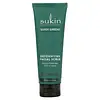What's inside
What's inside
 Key Ingredients
Key Ingredients

 Benefits
Benefits

 Concerns
Concerns

 Ingredients Side-by-side
Ingredients Side-by-side

Water
Skin ConditioningAloe Barbadensis Leaf Juice
Skin ConditioningSesamum Indicum Seed Oil
EmollientCetearyl Alcohol
EmollientBambusa Arundinacea Stem Extract
Skin ConditioningCetyl Alcohol
EmollientCeteareth-20
CleansingJojoba Esters
EmollientSpirulina Platensis Extract
Skin ProtectingChlorella Vulgaris Extract
Skin ConditioningPetroselinum Crispum Extract
Skin ConditioningBrassica Oleracea Acephala Leaf Extract
HumectantGlycerin
HumectantSimmondsia Chinensis Seed Oil
EmollientRosa Canina Fruit Oil
EmollientCitrus Aurantifolia Peel Oil
MaskingAnanas Sativus Fruit Extract
Skin ConditioningGlycyrrhiza Glabra Root Extract
BleachingParfum
MaskingTocopherol
AntioxidantCitric Acid
BufferingPhenoxyethanol
PreservativeBenzyl Alcohol
PerfumingWater, Aloe Barbadensis Leaf Juice, Sesamum Indicum Seed Oil, Cetearyl Alcohol, Bambusa Arundinacea Stem Extract, Cetyl Alcohol, Ceteareth-20, Jojoba Esters, Spirulina Platensis Extract, Chlorella Vulgaris Extract, Petroselinum Crispum Extract, Brassica Oleracea Acephala Leaf Extract, Glycerin, Simmondsia Chinensis Seed Oil, Rosa Canina Fruit Oil, Citrus Aurantifolia Peel Oil, Ananas Sativus Fruit Extract, Glycyrrhiza Glabra Root Extract, Parfum, Tocopherol, Citric Acid, Phenoxyethanol, Benzyl Alcohol
Water
Skin ConditioningKaolin
AbrasiveTalc
AbrasiveButylene Glycol
HumectantBentonite
AbsorbentGlyceryl Stearate
EmollientCyclopentasiloxane
EmollientArgania Spinosa Kernel Oil
EmollientMentha Piperita Leaf Extract
Skin ConditioningHoney
HumectantHamamelis Virginiana Leaf Extract
Skin ConditioningCitrus Sinensis Peel Extract
PerfumingRoyal Jelly Extract
Skin ConditioningXanthan Gum
EmulsifyingCitric Acid
BufferingGlyceryl Stearate Se
EmulsifyingCeteth-20
CleansingPalmitic Acid
EmollientMineral Salts
Skin ConditioningMethicone
EmollientMoroccan Lava Clay
AbrasiveZinc Phosphate
Phenoxyethanol
PreservativeEthylparaben
PreservativeMethylparaben
PreservativeParfum
MaskingCI 77492
Cosmetic ColorantWater, Kaolin, Talc, Butylene Glycol, Bentonite, Glyceryl Stearate, Cyclopentasiloxane, Argania Spinosa Kernel Oil, Mentha Piperita Leaf Extract, Honey, Hamamelis Virginiana Leaf Extract, Citrus Sinensis Peel Extract, Royal Jelly Extract, Xanthan Gum, Citric Acid, Glyceryl Stearate Se, Ceteth-20, Palmitic Acid, Mineral Salts, Methicone, Moroccan Lava Clay, Zinc Phosphate, Phenoxyethanol, Ethylparaben, Methylparaben, Parfum, CI 77492
Ingredients Explained
These ingredients are found in both products.
Ingredients higher up in an ingredient list are typically present in a larger amount.
Citric Acid is an alpha hydroxy acid (AHA) naturally found in citrus fruits like oranges, lemons, and limes.
Like other AHAs, citric acid can exfoliate skin by breaking down the bonds that hold dead skin cells together. This helps reveal smoother and brighter skin underneath.
However, this exfoliating effect only happens at high concentrations (20%) which can be hard to find in cosmetic products.
Due to this, citric acid is usually included in small amounts as a pH adjuster. This helps keep products slightly more acidic and compatible with skin's natural pH.
In skincare formulas, citric acid can:
While it can provide some skin benefits, research shows lactic acid and glycolic acid are generally more effective and less irritating exfoliants.
Most citric acid used in skincare today is made by fermenting sugars (usually from molasses). This synthetic version is identical to the natural citrus form but easier to stabilize and use in formulations.
Read more about some other popular AHA's here:
Learn more about Citric AcidParfum is a catch-all term for an ingredient or more that is used to give a scent to products.
Also called "fragrance", this ingredient can be a blend of hundreds of chemicals or plant oils. This means every product with "fragrance" or "parfum" in the ingredients list is a different mixture.
For instance, Habanolide is a proprietary trade name for a specific aroma chemical. When used as a fragrance ingredient in cosmetics, most aroma chemicals fall under the broad labeling category of “FRAGRANCE” or “PARFUM” according to EU and US regulations.
The term 'parfum' or 'fragrance' is not regulated in many countries. In many cases, it is up to the brand to define this term.
For instance, many brands choose to label themselves as "fragrance-free" because they are not using synthetic fragrances. However, their products may still contain ingredients such as essential oils that are considered a fragrance by INCI standards.
One example is Calendula flower extract. Calendula is an essential oil that still imparts a scent or 'fragrance'.
Depending on the blend, the ingredients in the mixture can cause allergies and sensitivities on the skin. Some ingredients that are known EU allergens include linalool and citronellol.
Parfum can also be used to mask or cover an unpleasant scent.
The bottom line is: not all fragrances/parfum/ingredients are created equally. If you are worried about fragrances, we recommend taking a closer look at an ingredient. And of course, we always recommend speaking with a professional.
Learn more about ParfumPhenoxyethanol is a preservative that has germicide, antimicrobial, and aromatic properties. Studies show that phenoxyethanol can prevent microbial growth. By itself, it has a scent that is similar to that of a rose.
It's often used in formulations along with Caprylyl Glycol to preserve the shelf life of products.
Water. It's the most common cosmetic ingredient of all. You'll usually see it at the top of ingredient lists, meaning that it makes up the largest part of the product.
So why is it so popular? Water most often acts as a solvent - this means that it helps dissolve other ingredients into the formulation.
You'll also recognize water as that liquid we all need to stay alive. If you see this, drink a glass of water. Stay hydrated!
Learn more about Water